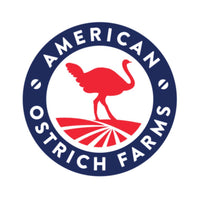“It’s a bird, but it tastes like a mammal and cooks like a fish,” Lou Braxton said as he extended a frozen fillet towards me. It’s a line he’s perfected over his four years selling ostrich at the Union Square greenmarket in Manhattan. The cut, no larger than a filet mignon, was dark red—nothing like the white meat I associated with poultry.

One of these cuts is ostrich, the other is beef. But which one's which? PHOTO BY BOBBI LIN
“What cut of the animal is this from?” As I asked, a Great Dane trotted into the white tent, pulling his owners at the other end of his leash, to smell an ostrich femur. “That one,” Lou responded, pointing at the two-foot long leg bone.
When I spoke with Alex McCoy, an ostrich farmer in Idaho, on the phone a few days earlier, he had just come in from a long morning of rotating his male ostriches into new pens. “Breeding season,” he said, in a tone that suggested I could commiserate. (As he later explained, the males get agitated during fall’s breeding season, thus they have to be moved until they find the right pen.)
Just three years ago, before Alex and his wife launched their Idaho-based ostrich farm by way of Kickstarter, he was an investment banker. When his job took him to South Africa in 2012, it was the first time he’d ever seen the bird sold as meat. “At one point,” he recalled, “I found myself in a grocery store in the ostrich aisle—just like how there are beef and chicken aisles in the States.” He purchased a steak and immediately fell in love with it: “It’s 97% fat-free and looks and feels like a high-end steak, but it cost me far less,” he said. That economic efficiency and the sustainability of the meat—more on that later—appealed to his business background: “It felt like a secret,” he said.
This article was originally published by Food52
https://food52.com/blog/16405-the-little-known-red-meat-that-s-more-sustainable-than-beef






